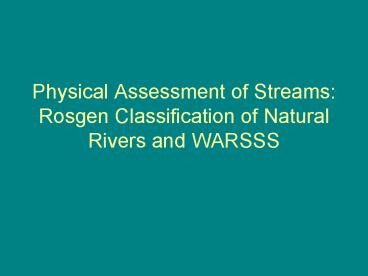Physical Assessment of Streams: Rosgen Classification of Natural Rivers and WARSSS - PowerPoint PPT Presentation
1 / 27
Title:
Physical Assessment of Streams: Rosgen Classification of Natural Rivers and WARSSS
Description:
Physical Assessment of Streams: Rosgen Classification of Natural Rivers and WARSSS – PowerPoint PPT presentation
Number of Views:427
Avg rating:3.0/5.0
Title: Physical Assessment of Streams: Rosgen Classification of Natural Rivers and WARSSS
1
Physical Assessment of Streams Rosgen
Classification of Natural Rivers and WARSSS
2
Rosgen Classification of Natural Rivers
3
Rosgen
4
(No Transcript)
5
(No Transcript)
6
Rosgen
7
Rosgen Stream Stability Analysis
8
Departure from Existing Condition
9
Rosgen, fgmorph
Field Assessment of Erosion Potential (BEHI)
10
Williams Creek, Fall 2007
J. Webber
11
Channel Adjustment Tendency
12
Channel Evolution and Departure
13
Channel Evolution and Return
14
Watershed Assessment of River Stability
Sediment Supply (WARSSS)
15
Why WARSSS?
- The U.S. Environmental Protection Agency
supported the development of WARSSS by Dr. David
L. Rosgen because there is limited guidance on
assessing sediment impairments. - WARSSS can be used to analyze known or suspected
sediment problems, develop sediment remediation
and management components of watershed plans,
develop sediment TMDLs (Total Maximum Daily
Loads), and other uses. - This web-based assessment tool was designed for
scientists who need to assess sediment-impaired
waters in planning for their restoration.
16
USEPA
17
USEPA
18
USEPA
Reconnaissance Level Assessment
19
Reconnaissance Level Assessment (RLA)
- Identify places in the watershed that represent
likely sediment sources and channel stability
problems, and thereby limit the effort and costs
of the more intensive WARSSS phases - Begin assembling and examining existing
information - Verify or, if needed, clarify or redirect the
problem identification - Eliminate sub-watersheds, reaches or areas within
the watershed (e.g., stable slopes) that do not
contribute excessive sediment - Locate and focus on potentially important problem
areas, reaches, or sub-watersheds for the next
phase, RRISSC level assessment
20
Rapid Resource Inventory for Sediment Stability
Consequence (RRISSC)
21
Rapid Resource Inventory for Sediment Stability
Consequence (RRISSC)
- Sensitive landscapes, potentially unstable stream
systems, and sediment-generating land use
activities need to be identified, prioritized,
and assessed for potential impacts at a level of
detail beyond their initial flagging in RLA. - The Rapid Resource Inventory for
Stability/Sediment Consequence (RRISSC) is
designed to provide this finer level of analysis.
- Time required to assess a 3rd order watershed
using the RRISSC is measured in a few weeks
(rather than days or months), depending on
availability of land cover maps, aerial
photographs, soils information, and access to
land use history.
22
Rapid Resource Inventory for Sediment
Stability Consequence (RRISSC)
- type and extent of land uses
- the erosion potential of the landscape and
channel - relationship of potential sediment sources to
hillslope, hydrologic and channel processes
23
USEPA
Prediction Level Assessment (PLA)
24
Prediction Level Assessment (PLA)
- The most detailed level of investigation for
slopes, sub-watersheds and river reaches
previously identified as being high risk
associated with sediment and/or river stability
problems. - Due their sensitive nature, the value of the
resource, the severity of the adverse consequence
of impairment, and other compelling reasons, it
becomes necessary to conduct this level of
analysis.
25
Prediction Level Assessment (PLA)
- Utilizes "reference condition" that represents
stable natural land and/or stream systems to
compare direction, rate, nature and extent of
departure from natural rates of sediment and/or
natural stability using the same assessment
methodology. - These comparisons to reference sediment and
stability condition are used to identify
potential departure, and to document acceptable
erosional/sedimentation rates.
26
The Reference Reach
- The reference reach is a river segment that
represents a stable channel within a particular
valley morphology. - The reference reach is used to develop natural
channel design criteria based upon measured
morphological relations associated with the
bankfull stage for a specific stable stream type.
- Specific data on stream channel dimension,
pattern, and profile are collected and presented
by dimensionless ratios by stream type. - The morphological data collected are used for
extrapolation to disturbed, or unstable reaches
in similar valley types for the purposes of
restoration, stream enhancement, stabilization,
and stream naturalization schemes. - Bankfull discharge and dimensions from stream
gage stations for a particular hydro-physiographic
regions are correlated with drainage area to
develop regional curves for extrapolation to
non-gaged reaches.
Rosgen
27
Williams Creek, Fall 2007































